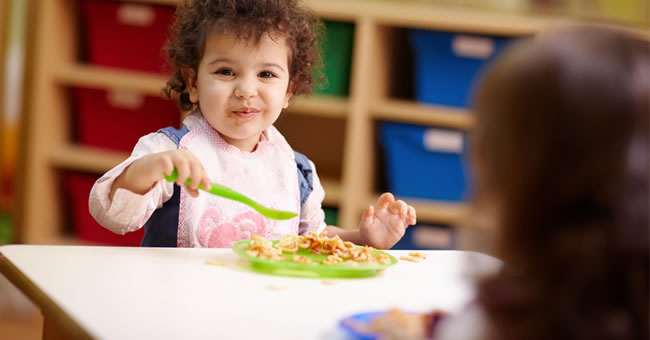
Even though there was a decrease in obesity from 2003-2004 to 2011-2012 for 2- to 5-year-olds, childhood obesity remains prevalent in the United States with about 17 percent of children 2-19 years old being obese (CDC). Teaching children about nutrition at a young age and furthering their knowledge as they grow and develop is one of the best ways we can combat childhood obesity and help children increase their health and well-being. Preschoolers are at the crucial age where they can begin to understand how nutrition plays a major role in their lives, which is why nutrition is such an important component to include in preschoolers' learning. Here are a few tips for educators on teaching preschoolers about nutrition:
- Give preschoolers simple nutrition guidelines. Start off with simple, basic nutrition guidelines that are easy for young children to understand and remember, such as always eat a healthy breakfast, drink lots of water, and try to eat a variety of colors at each meal. Introducing children to MyPlate, talking about portion sizes, and giving children examples of how they can measure the correct portions for different items are all great ways to start teaching children about nutrition.
- Encourage preschoolers to try new foods. Children of any age can be picky eaters, but they won't expand their tastes or discover what foods they like until they try a variety of foods. Try bringing in different fruits and vegetables for children to touch, smell, and/or taste. Teaching children about international foods can also encourage children to keep an open mind when trying new foods.
- Keep healthy snacks on hand in your classroom. Encourage responsible, healthy snacking in your classroom by keeping a variety of healthy treats on hand for children. Fruits (apples slices, grapes, etc.), vegetables (carrots, celery, etc.), and raisins are all examples of great snacks for preschoolers. Remember to be mindful of food allergies when choosing snacks for your classroom or center. Be sure to also encourage parents to pack healthy snacks/lunches for their preschoolers and to keep a variety of healthy snacks on hand at home.
- Discuss nutrition through a variety of fun activities. Incorporating nutrition guidelines and facts in a variety of fun activities is one of the best ways for young children to learn and retain the information they need to make healthy choices. Dancing to a song about vegetables, looking at bilingual photo cards, and playing a nutrition game are just a few examples of fun nutrition activities you can do with your preschoolers.
- Make sure various food groups are represented in the dramatic play area. The dramatic play center is an integral part of any preschool classroom, which is why it's important that different food groups and other items related to nutrition are available for children to use while they play. Provide realistic pretend food for children to shop for, bake, cook, and serve. This would also be a good way to introduce preschoolers to food from around the world.
- Include books about nutrition in your classroom or center library. Keeping books about special diets, healthy eating, and other nutrition concepts routinely available to preschoolers in your classroom or center library will reinforce the nutrition concepts you're teaching preschoolers in the classroom while also giving them an opportunity to learn about nutrition on their own.
- Provide preschoolers with opportunities for active play. Active play is essential in helping preschoolers develop gross motor skills, coordination, and balance, but active play also plays an important role in children's overall health. Teaching children about nutrition and encouraging them to be physically active are both essential elements in combatting and preventing childhood obesity. Whether it's playing hopscotch, tossing bean bags, or doing yoga for kids, you should try to ensure that the preschoolers in your care have several opportunities for active play each day.
- Consider using a supplemental nutrition curriculum. Using a supplemental nutrition curriculum, such as LANA (Learning About Nutrition Through Activities), can help you come up with classroom and family engagement activities that promote healthy eating while teaching children important nutrition concepts. Incorporating a variety of gardening activities into your lesson plans is another great way you can teach children about nutrition and the food they eat.
- Be a nutrition role model. Young children look up to the important adults in their life, so make an effort to show children that you practice what you teach. Eating fruits and vegetables for snack or at lunch and talking with children about new foods or recipes you try are just a few examples of how you can be a nutrition role model for preschoolers.
Browse our Nutrition section for a variety of educational materials you can use to teach preschoolers about nutrition.
Related Articles
Teaching Elementary Students About Nutrition
Preventing Childhood Obesity
Incorporating Gardening into Your Lesson Plans
